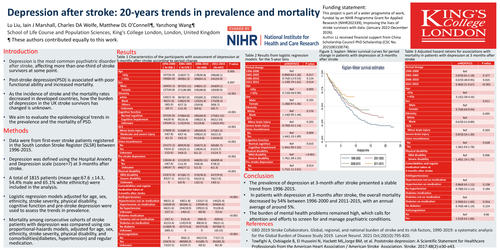Poster Presenter
Affiliations
Audio
0:00 / 0:00
Rate
Depression after stroke: 20-years trends in prevalence and mortality
Introduction
•Depression is the most common psychiatric disorder after stroke, affecting more than one-third of stroke survivors at some point.
•Post-stroke depression(PSD) is associated with poor functional ability and increased mortality.
•As the incidence of stroke and the mortality rates decreased in developed countries, how the burden of depression in the UK stroke survivors has changed is unknown.
•We aim to evaluate the epidemiological trends in the prevalence and the mortality of PSD.
Methods
•Data were from first-ever stroke patients registered in the South London Stroke Register (SLSR) between 1996-2015.
•Depression was defined using the Hospital Anxiety and Depression scale (score>7) at 3-months after stroke.
•A total of 1815 patients (mean age:67.6 ±14.3, 54.4% male and 65.1% white ethnicity) were included in the analysis.
•Logistic regression models adjusted for age, sex, ethnicity, stroke severity, physical disability, cognitive function and pre-stroke depression were used to assess the trends in prevalence.
•Mortality among consecutive cohorts of stroke patients with depression was compared using cox proportional-hazards models, adjusted for age, sex, ethnicity, stroke severity, physical disability, and comorbidities(diabetes, hypertension) and regular medication.
Conclusion
•The prevalence of depression at 3-month after stroke presented a stable trend from 1996-2015.
• In patients with depression at 3-months after stroke, the overall mortality decreased by 54% between 1996-2000 and 2011-2015, with an annual average of around 5%.
•The burden of mental health problems remained high, which calls for attention and efforts to screen for and manage psychiatric conditions.

